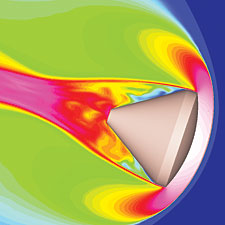
|
Some Common Myths Thought to be True - Myth 36
Myth 36: Spacecraft Heat of Reentry - Caused by Friction of Air
When a spacecraft reenters the atmosphere, the heat of reentry is not
(primarily) caused by friction, but by adiabatic compression of air in front of
the spacecraft.
|
| Meteorite Heat on Reentry | |
|
Adiabatic heating also occurs in the Earth's atmosphere when an air mass
descends, for example, in a katabatic wind or Foehn or chinook wind flowing
downhill over a mountain range. When a parcel of air descends, the pressure on
the parcel increases. Due to this increase in pressure, the parcel's volume
decreases and its temperature increases, thus increasing the internal
energy.
|
|
| ⇦ Back to Myth 35 Return to Myth Choices Page 3 On to Myth 37 ⇨ | |